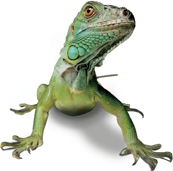29.1 Elements of Behavior
 What is the significance of behavior in the evolution of animal species?
What is the significance of behavior in the evolution of animal species? What is an innate behavior?
What is an innate behavior? What are the major types of learning?
What are the major types of learning? How do many complex behaviors arise?
How do many complex behaviors arise?
behavior • innate behavior • learning • habituation • classical conditioning • operant conditioning • insight learning • imprinting
Concept Map As you read, create a concept map to organize the information in this section.
MYSTERY CLUE

Researchers have noticed that elephants living elsewhere exhibit behaviors similar to those of the elephants at the watering hole. What does this suggest about the importance of these behaviors?
THINK ABOUT IT about it At a table by a Caribbean seaside restaurant, a young tourist eats a hamburger, unaware that he's being watched—by an iguana. The lizard crawls closer, looking dangerous. The boy spots him and, with a cry of fear, jumps up onto his chair. But the iguana isn't interested in human toes. This lizard, a shy tree-dwelling species, is a vegetarian. He makes a beeline for the French fries that the boy, in his panic, knocked to the ground. What's so interesting about this scene? These iguanas normally don't approach humans. And they're not known for being as clever as, say, dogs or cats. But this particular male iguana has learned that getting close to humans can mean easy access to food.

Behavior and Evolution
 What is the significance of behavior in the evolution of animal species?
What is the significance of behavior in the evolution of animal species?
The activity of that hungry iguana is just one example of behavior, which is usually defined as the way an organism reacts to stimuli in its environment. Some behaviors are as simple as a dog turning its head and pricking up its ears in response to a noise. Other behaviors can be quite complex. For example, some animals wash some of their food before eating it. Usually, behaviors are performed when an animal detects and responds to some sort of stimulus in its environment. The way an animal responds to a stimulus, however, often depends on its internal condition. If our friend the iguana hadn't been hungry, for example, it would probably have kept its distance from the boy and his French fries!
Many behaviors are essential to survival. To survive and reproduce, animals must be able to find and catch food, select habitats, avoid predators, and find mates. Behaviors that make these activities possible are therefore as vital to survival and reproduction as any physical characteristic, such as teeth or claws.

Table of Contents
- Formulas and Equations
- Applying Formulas and Equations
- Mean, Median, and Mode
- Estimation
- Using Measurements in Calculations
- Effects of Measurement Errors
- Accuracy
- Precision
- Comparing Accuracy and Precision
- Significant Figures
- Calculating With Significant Figures
- Scientific Notation
- Calculating With Scientific Notation
- Dimensional Analysis
- Applying Dimensional Analysis




